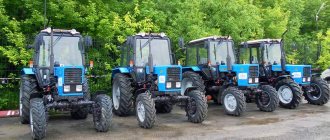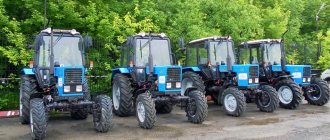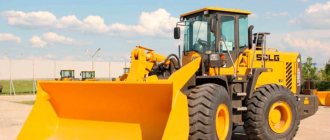- home
- Media center
- Articles
- Tractor consumption rate
Menu
- News
- Articles
- Video materials
- Photo materials
- Publication in the media
- 3D tour
15.07.2020
One of the basic components of any tractor in terms of design is the engine, which must correspond to a certain level of power. This is due to the functionality of the machine, which is designed to perform a number of heavy earthworks. The latter require significant fuel consumption, so there is a need to calculate this indicator for the purpose of further planning for the entire season.
The fuel consumption rate makes it possible to calculate all costs, including the fuel budget. But it is important to take into account all the factors influencing this indicator. Here we are talking about unevenness of the soil, regular changes in load due to changes in density, runout in trailed units, etc. All this together allows us to determine the maximum and minimum values of fuel consumption for tractors. For example, minimum volumes are suitable for situations involving movement on flat road surfaces.
Normalized fuel consumption
Each manufacturer indicates standardized fuel consumption values for each equipment modification. They are determined based on the characteristics of the internal combustion engine and all units that will be connected to it. The rate will vary for different operations:
- For driving on the road surface without a trailer or other devices. For example, a T-30-69 type tractor in transport mode to the place of work consumes no more than 7.2 liters of diesel fuel per 1 machine-hour.
- When clearing the roadway of snow, the same tractor consumes up to 19.7 liters per 1 machine-hour.
- If the tractor is universal, then the consumption rate of the fuel and lubricant mixture will change differently. For example, hauling a trailer requires less fuel than sweeping or cutting grass on the side of the road with a mounted scythe.
Table of fuel consumption rates for different models of wheeled tractors
| Vehicle model | Engine type and model | Consumption in liters per 1 machine-hour of operation |
| Tractor Belarus-622 | LDW-2204/T | In the mode of traveling to a place or parking - up to 4.5 liters. Transporting a trailer – up to 5.5 liters. |
| MTZ-82 | D-240 | Working with a brush – up to 4.3 liters. Procedures with a blade - up to 4.4 liters. Mowing grass – 5.6 l. |
| MTZ-82.1 | D-243 | Movement with a brush – up to 5 l. Trailer towing – 7 liters. Loading and handling loads – 3.5 l. Platform towing capacity – up to 9.4 liters. |
| MTZ-80 | D-240 | Working with a cleaver type Japa 60ja110 – up to 4 l. Transporting a trailer – up to 6.4 liters. |
| MTZ-50 | D-240L | Towing a trailer type 2PTS-4 – up to 5.3 liters. Towing an IAPZ-754V trailer – up to 5.3 liters. |
| K-701 | YaMZ-240BM2-1 | Movement without load – up to 28.1 liters. Carrying out snow removal with a blade - up to 20 liters. |
| Belarus-892 | D-245.5 | Transportation of trailer 2PTS-4.5 – up to 7 liters. Transporting two trailers – up to 8.6 liters. |
The fuel consumption of tractors in different modes will be different due to the characteristics of each operation. Let's say there is a need to clear snow. In this case, the indicator will increase evenly due to the strong resistance of the material with which you have to work.
In addition to the types of specific work and operating modes, fuel consumption is influenced by the type of chassis of the tractor. The presence of a tracked system adds mass to the vehicle, which leads to higher consumption.
Classification of roads by type and condition of the road surface:. Calculation formula
Please note that to find out how much the MTZ-82 tractor weighs, you must take into account that the maximum permissible weight with attachments cannot be higher than 6.5 tons, while the nominal weight of the equipment is 3.75 tons, that is The maximum weight of attachments should be no more than 3250 kg. Model of agricultural implement Fuel consumption 8310R 60.2 l h 8320RT 65 l h 8335R 67.5 l h 8420R 54.8 l h 8430R 56.4 l h 8520R 58.7 l h 8530R 63 l h.
| Message |
What affects the fuel consumption of tractors?
This issue is usually considered on the basis of overruns, which may arise due to various reasons. The main one is the technical condition of a particular tractor, therefore, before starting work, the internal combustion engine should be checked for faults. But other reasons should also be taken into account:
- The second factor that directly affects fuel consumption is the operator's driving style.
- Weather conditions and seasonality.
- Landscape features, including the type of road surface and its current condition.
- Trailer load capacity.
Factors
One of the issues of checking the financial and economic activities of an enterprise is the procedure for applying orders for fuel consumption of vehicles. The Ministry of Transport and Communications has developed linear cost standards that must be taken into account by all owners of equipment, regardless of the form of ownership and departmental subordination.
The linear norm is the volume of fuel that is consumed by a technically sound tractor per 100 km without taking into account the increase or decrease in additional fuel consumption. The amount of increase and decrease in percentage is set by the heads of organizations.
What is the first thing you need to pay attention to when using these normalized values? First of all, you must follow the instructions for use.
Why is it important to know the tractor consumption rate? This allows you to correctly calculate all associated costs and determine the budget. However, when carrying out computational operations, we must not forget about the accompanying factors that influence the final indicators. Unevenness of the soil, frequency of changes in the load mode, runout in the trailed unit, etc. – all this determines fuel costs.
The key factor on which consumption depends is the current technical condition. Before starting work, it must be checked for breakdowns and malfunctions.
In addition, diesel fuel consumption rates for tractors are affected by:
- driving style;
- features of road and landscape surfaces;
- carrying capacity and degree of loading of the vehicle.
Weather conditions and seasonality can also reduce or increase fuel costs.
Basic consumption rates
The operating instructions for each tractor model are the main documents that indicate fuel consumption. It should be taken into account that all formulas used for calculations there are suitable for idealized stable conditions. Here we mean a full load of the unit, a dry and flat road surface, no precipitation, etc. In this regard, the calculation of fuel consumption should be carried out for each vehicle separately and take into account the operating conditions in which the special equipment finds itself.
Most tractor models assume a universal format of use, so when viewed in the abstract, it is not easy to calculate fuel consumption for each type of work separately. To do this, use data with basic fuel consumption rates according to the documentation supplied with the equipment. They represent average values for consumption, which was identified as the average consumption in all modes.
Listed below are some of the common types of tractors with different fuel consumption indicators:
- To complete the transportation process, an ATS-59 tractor with a 370 kW engine unit will require an average of up to 54.1 liters per hour. This is heavy equipment that is capable of moving over rough terrain and at the same time transporting a trailer or towing other equipment.
- The K-700 wheeled tractor with the YaMZ-8424 power unit consumes an average of 22.7 liters per hour.
- Tractors of the T-25 model with D-120 diesel engines with a power of up to 23.5 kW consume up to 2.5 liters during main activity and transportation.
As can be seen from the description, the fuel consumption rate varies greatly from one tractor model to another and depends on a host of factors. In any case, it will not be possible to accurately calculate, because not only the operating modes change, but in addition there are risks with the occurrence of malfunctions. The latter greatly affect the fuel consumption of the tractor, which is no longer consistent with the norm. Let's say one of the cylinders fails. In this case, consumption will increase sharply and power will decrease. This will be due to the fact that the operator will try to increase the speed with gas in the first minutes.
Calculation algorithm
Without knowledge of the fuel consumption rate for tractors, it is impossible to adequately estimate the costs of maintaining equipment. To make all measurements correctly, the car must travel at least 100 km. As soon as this distance has been covered, the volume of fuel consumed is determined. The equipment (including components and assemblies) must be in full working order.
Consumption indicators are calculated using the formula:
P=0.7*R*N, where R – specific consumption; N – device power; P – fuel costs per unit of time (60 min).
When performing computational operations, do not forget that each model has a different load capacity. This feature also affects the final values. To minimize the error, a correction factor is used. At full load it is 1, at partial load it is 0.8; at half – 0.5; with partial – less than 0.5.
Tractor MTZ-80: application
If necessary, a milling cutter of a technological type can be additionally attached to the tractor system of special equipment; universal small-sized working excavator of a chain version, type ECU-150; mounted type of technological trailer; a professional version of the grab loader-excavator series PE-F-1 B BM, industrial attachments in the form of a snow blower with a special rotary auger; industrial production technological rakes based on the design of the tedder; a graduated complex that crushes plant bushes and branches; as well as a full-fledged agricultural harrow. R specific fuel consumption, measured in gkW hour, can range from 220 to 260 gkW hour, usually the number is indicated in the operating instructions or in the technical description of the tractor.
MTZ-1221 owner reviews
- Maxim, Bryansk. I am the owner of the MTZ-1221 tractor with 3200 operating hours. The car is equipped with a six-cylinder D-260 turbo unit, which has proven itself to be the best - high-torque and provides good acceleration dynamics. The tractor itself copes with the assigned tasks, largely due to its good cross-country ability and high-torque. However, the machine will serve faithfully if it is regularly repaired. This is due to frequent breakdowns. The car is from 2008. The very first serious breakdown occurred with the metering pump, which failed. This unit broke down after the first month of operation. The service center repaired it under warranty, but these were only minor problems - a month later, problems arose with the distributor rod, then I discovered a leak in the plastic cuffs. But we fixed all this ourselves. Of other breakdowns, the most common is the input shaft bearing falling apart. Just recently I discovered oil leaks that were leaking from under the differential lock housing. There is no time to disassemble it, let it work for now. I can assume that there is a problem with the membrane. Another weak point of the MTZ-1221 tractor is its small fuel tank, which is not enough for long hours of operation. Under heavy loads, the tank empties very quickly, for example during cultivation. Because of this, you have to refuel twice a day. In addition, I can also complain about the power take-off shaft. It has frankly weak performance - so much so that the belts cannot withstand (under load), it is advisable to change them every season. The new tractor was equipped with a SPA 1157 alternator belt, which eventually broke. For a long time we could not find exactly the same belt. In general, we decided to take another model - A-1180. This belt is less reliable and must be changed twice in one season. The quality of the belt is not very good, the original one is much better. The MTZ-1221 tractor is equipped with a low-capacity battery, although this is hardly a secret to anyone. The radiator worked fine for the first year, but then constantly overheated. The “on-call specialists” couldn’t really do anything, apparently their knowledge is not much different from our knowledge. In short, we changed the radiator, because there’s already enough dancing with a tambourine. The machine consumes a maximum of 20 liters per hour.
- Alexander, St. Petersburg. The tractor was manufactured in 2012, and in six years of operation it has never let me down in any major way. Moreover, the MTZ-1221 model is practically not inferior in power to the T-150K tractor. The machine performed excellently in the forest, has a high load capacity and a powerful engine. I installed forks on the bucket, and I turned the standard spreader trailer into a homemade timber truck. The result is an affordable and efficient solution for transporting wood. Of course, in terms of carrying capacity, the MTZ-1221 is clearly inferior to the Urals, which have special equipment for removing timber. And yet, my tractor copes with labor-intensive tasks. The car has a large set of advantages, and the disadvantages can be counted on one hand. For example, among the little things, I will note the operation of the rear linkage, which lowers very slowly in winter. The tractor is also too voracious for its price category - fuel consumption is around 20 liters. When transporting timber, the engine roars and rattles at high speeds, and it often reaches the point of overheating. I fill up twice during the whole working day. It is also necessary to periodically change or tighten the bolts in the front axle sleeves, which often break off under overload.
- Nail, Tomsk. I got a job at an agricultural company. I was provided with a MTZ-1221 tractor of the 2010 model year. The car was in excellent condition, practically new. In operation since 2011 (then I got a job). In general, the tractor does not cause problems, provided that it is serviced in a timely manner. Naturally, malfunctions arise from time to time, which can be easily eliminated if the hands grow from the right place. So, one of the first problems was with the engine, namely antifreeze was leaking. At first I thought it was all about the gaskets that should just be replaced. Nothing has changed - the replacement did not help. After much deliberation in the workshop, I finally discovered one of the plugs was defective. The craftsmen machined another plug, I installed it, and the antifreeze stopped flowing. The gearbox works smoothly and does not cause any problems. The same can be said about the clutch - it works like a clock. In general, the transmission has been left untouched for now, but its time will surely come. The fuel tank lasts for a maximum of half a working day due to the high consumption of diesel fuel. The six-cylinder diesel loves fuel, although it can be filled with fuel that is not of the best quality. In the spring, I often work with the KPS-8 cultivator, with which the consumption increases greatly - it comes out to around 25 liters per hour! Therefore, we can say with confidence that the 1221 tractor is not suitable for this cultivator, but I don’t have another model. In addition, the tractor is equipped with a small radiator, which overheats greatly under increased loads. I connected many different attachments to this model, including a five-furrow plow, borrowed from the T-150 model. There are no problems with this plow, the tractor runs normally and doesn’t strain too much. In the winter season, MTZ-1221 is never idle, just like in the summer. The cabin is warm and cozy, if you ignore the hard seat. Although after a long day of work, my back still gets stiff. With the onset of autumn, it will be necessary to change the tires, since the tread has already worn out. We can conclude that the MTZ-1221 does its job well. It breaks regularly, but can be repaired in the field. Fortunately, most breakdowns can be repaired according to the instructions.
- Konstantin, Moscow. I have a 2012 MTZ-1221 tractor, a powerful and productive machine, very voracious and does not require serious expenses. The main costs are for fuel. Without any doubt, I can say that the MTZ-1221 tractor is endowed with high power, because its six-cylinder diesel engine is capable of much. The machine is adapted for transporting timber, for road construction, and for planting forests. Attachments can be connected to different brands. For example, we had a standard spreader trailer that could easily be converted into a timber truck for transporting wood. It’s inconvenient that you have to unhook before loading or unloading, otherwise there’s no other way. But we must pay tribute - a homemade timber carrier is not much inferior to the mighty Urals, which are far superior in performance to my MTZ-1221. The trailer volume is acceptable. In road construction, the tractor was useful for transporting sand. To do this, I have a spacious bucket into which you can quickly load any bulk materials. The engine is a six-cylinder, with a turbine, and its thrust is practically not inferior to the T-150K. I would like to note the reliable steering mechanism. The control is of a hydrostatic type, thanks to which the machine steers easily, even with a fully loaded bucket of sand. The tractor is easy to operate even for a novice driver. The rear linkage is reinforced with two hydraulic cylinders, but in the winter the speed of lowering the linkage leaves much to be desired - it lowers very slowly. The fact is that the tractor does not have a forced lowering function. But I liked that the locking and front axle can be turned on by pressing a button, and after that the tractor turns into an all-wheel drive all-terrain vehicle. The car is too voracious, fuel consumption often exceeds 20-22 liters per hour. I fill up twice in one day. The front axle of the MTZ-1221 tractor contains a flaw - the bolts securing the sleeves break off. The load on the front axle is colossal, which may be why it breaks. But the tractor is worth the money spent. I don't regret buying it.
- Alexey, Minsk. I became acquainted with this tractor in 2006. The car is equipped with a D-260 engine, which produces an honest 140 horsepower and consumes 20-25 liters depending on the load. Six cylinders confidently pull the tractor out of any hole, despite the weak power. The torque is colossal, the traction reserve is present in a wide speed range, even at maximum load. And if it’s really a burden, you can use all-wheel drive. The rear linkage has two hydraulic cylinders, thanks to this you can hope for a power reserve. The front axle can be engaged in automatic mode or manually - to do this you need to press the coveted button. I liked that the engine power is comparable to the T-150. During the first two years of operation, the car never failed me in a big way, I was pleasantly surprised. After all, I got a practically new car, but after a week of use the clutch accidentally failed - this was the only serious breakdown, since then the car has served me well. I know firsthand that the 1221 tractors of previous years of production were equipped with two twin fuel tanks, but newer machines are content with plastic tanks. I think this is a controversial decision, because such a tank can easily be damaged when driving through a deep rut, for example. And Belarusians just want to reduce the price, although the tractor itself is becoming more expensive every year - inflation, they say. And the quality is deteriorating. The intake is installed on top, like a car. If the tube becomes clogged, you have to disassemble most of the cabin to get to the tube. The machine consumes between 12-25 liters per hour.
- Mikhail, Ekaterinoslavl. The car impressed in all respects - passable and durable. I have not yet identified any serious flaws. Model 2015 release. I still work on this tractor. There are a lot of negative reviews about this car, but I have a purely positive opinion. At the same time, for the sake of fairness, it is necessary to talk about the shortcomings that the MTZ-1221 has - for example, in comparison with its predecessor MTZ-80. I mean increased fuel consumption - my car at peak load consumes around 25 liters per 100 km. Moreover, when overloaded, the front and rear axles weaken, which eventually wear out and break. Therefore, it is advisable not to overload the equipment, otherwise you can get into expensive repairs. But on the other hand, even the most serious breakdowns do not require such high costs as with foreign cars. I praise the tractor for its excellent maneuverability and spacious cabin. The seat is quite hard, I changed it to a softer one. The tractor doesn't look as scary as in the picture. It looks impressive from all angles - a classic tractor, what else can I say. Just right for farming, as well as for the construction and industrial sectors.
- David, Nizhny Novgorod region. This tractor is full of shortcomings that you can live with if you have no other choice. I work on a 2013 MTZ-1221. The vehicle has a reliable and high-torque diesel engine, has the highest cross-country ability and a spacious cabin. This is a universal tractor, suitable for most resource-intensive tasks in construction, agriculture, municipal services, industry, etc. It has a minimal set of electronics - it would seem that this is for the best, but breakdowns are still present. Increased fuel consumption, weak front axle and inconvenient rear glazing - this is also all about the MTZ-1221. He has many shortcomings. Front axles break due to overload. It's all about the gasket between the steering wheel and the driver's seat - my point is that operators must understand in what cases it is worth engaging the front axle, and in what cases it is undesirable to do so. All-wheel drive is a useful option, but it will not last long if used incorrectly. In fact, the tractor is durable if it is driven by an experienced driver. It is easy to repair, fortunately many spare parts are available - you can almost find them on a collective farm. The machine can be repaired both in the workshop and in the field. Serious disadvantages are the specific brakes, and I still haven’t gotten used to the gearbox. A manual transmission seems to be the norm, but it has as many as nine forward gears and the same number of reverse gears. I can’t imagine how to use all the gears - it’s inconvenient. They would have made an automatic transmission back then. But no, Belarusians need savings, and raising prices is our way, as they say. There is also no additional reduction gear in the box. By the way, in the highest 9th gear strong vibrations and rattling occur; the cabin is not comfortable due to the hard seat. But the interior is spacious, but there is no sound insulation. Visibility is excellent, but only if you don't connect a cart, otherwise visibility to the rear will suffer. Engine reliability and power are beyond praise; perhaps this is the most durable unit in the MTZ-1221 tractor. The engine thrust is sufficient for a wide range of different types of work. When off-road or when loaded, fuel consumption exceeds 20 liters, so you need to stock up on fuel.
- Evgeniy, Smolensk. Not a bad tractor. I bought it to replace the MTZ-80. In essence, MTZ-1221 is the same MTZ-80, only with a more powerful engine. There is also all-wheel drive - a very important and useful option, it improves cross-country ability and handling. The tractor is more stable on uneven surfaces, for example in deep ruts. Power is 140 horsepower. In addition, my car is equipped with a rear suspension with two hydraulic cylinders. Perhaps this model is much better than MTZ-82.1 (this is an improved version of MTZ-80). I also worked a little on 82.1, but the opportunity arose to upgrade to MTZ-2121. The only drawback compared to its two predecessors is increased fuel consumption. It is 25 liters for one hour of continuous operation, and under load. Therefore, sometimes you have to refuel two or even three times a day. In winter, the cabin is comfortable and warm, fortunately there is a powerful heater. And for comfortable work in the summer we had to install an air conditioner. Of course, you could limit yourself to power windows and a sunroof, but because of these drafts you can quickly catch a cold. In addition, when driving off-road, when the windows are open, dirt, dust, etc. gets into the cabin.
- Stanislav, Petrozavodsk. I have driven several thousand hours on this tractor. MTZ-1221 is the best option for a thrifty user who knows how to handle equipment so that it generates a stable income. The car is 2011, equipped with a heater, and also has a pre-heater. In my opinion, a six-cylinder diesel engine consumes much more than MTZ-80 or 82.1. This is understandable, because the engine power is almost twice as large - 140 versus 80 horses in favor of the MTZ-1221. Therefore, fuel consumption has almost doubled - it reaches 25 liters per hour of continuous loading. The tractor is especially voracious if you work with a cultivator or a five-furrow plow. Despite the gluttony, I liked the car. It has groovy dynamics and an impenetrable chassis - you can overcome any off-road areas without particularly straining. I recently installed an air conditioner myself, now in the summer it will be cool, and I won’t have to open the windows and breathe in dust and dirt.
- Sergey, Podolsk. I advise you to buy MTZ-1221 only from Belarusian assembly. The Belarusian car of recent years of production has various modifications, and the build quality is an order of magnitude higher than that of Russian-made models. I don't understand why this is so. I immediately changed the plastic tanks to more durable ones, made of a different material. I purchased the MTZ-1221 tractor in 2015. A solid and unpretentious device for long-term use with a powerful engine that has excellent traction. It is slightly noisy at medium speeds, and at maximum load you have to rev right up to the red zone, although the power of 140 horses is enough with a reserve. In this mode, the engine is endowed with aggressive dynamics, to which more powerful brakes would be added - the tractor brakes very weakly and nods. The car is more or less stable off-road only when all-wheel drive is engaged. And with the front axle engaged, fuel consumption increases even more. Sometimes it reaches 25-26 liters per hour. Unfortunately, the Belarusians have gone overboard with their gluttony. But other than that the tractor is excellent. It has a spacious and comfortable cabin. Fortunately, for the 2015 model it is possible to order additional options such as air conditioning and engine preheater. Standard wheels with deep tread, such tires are ideal for hilly and difficult terrain, for muddy soils, deep ruts and other obstacles. Malfunctions occur periodically, mainly affecting the chassis. The speed of the MTZ-1221 is noticeably higher than that of predecessor models of the MTZ-82.1 type. Perhaps the MTZ-1221 tractor will serve me for another five years, and then I will exchange it for a more modern model.
Rules for calculating the rate • Types of tractors
| Diesel fuel in agriculture, where it is used Therefore, fuel consumption is mainly calculated for each machine individually, depending on the conditions under which the operator has to work. Also, the calculation is carried out in liters, so in order not to translate everything according to tables and not make mistakes in the following calculations, it is necessary to use the improved calculation formula Q Nq 1000 R k1. |
- Fuel quality;
- Poor organization of storage, reception and delivery of fuel;
- Long idle runs of equipment;
- Poor quality maintenance of equipment;
- Improper aggregation of machines;
- lack of organization of preparation of working mechanisms.
When is it beneficial to use diesel fuel?
Due to the different operating principles of gasoline and diesel engines. The maximum power of cars using gasoline occurs at high speeds, which is extremely harmful for agricultural machinery. A diesel engine, on the contrary, immediately develops good torque and high power, even at low speeds. Naturally, when cultivating soil or crops, the speed of tractors and other self-propelled agricultural machinery is not required.
Diesel fuel is used in many sectors of the national economy where its properties are needed - efficiency and the ability of diesel engines to develop good torque.
The combine uses diesel fuel
Therefore, diesel fuel is used:
- in cars and trucks;
- Railway transport;
- Water transport;
- Military equipment;
- Construction;
- Heating of boiler rooms.
In agriculture, diesel fuel consumes:
- wheeled and tracked tractors;
- combines for various purposes;
- sowing agricultural machinery (seeders, planters);
- tillage agricultural machinery (fertilizer spreaders, units for applying liquid fertilizers, sprayers, cultivators, subsoilers, combined units, plows, disc harrows, compaction rollers);
- agricultural harvesting equipment (potato diggers, tractor semi-trailers);
- forage harvesting agricultural machinery (feed crushers, chopper-mixers, feed distributors, pick-ups, balers, mowers, packers).
Write-off of diesel fuel by engine hours
Another important parameter that interests both beginning and experienced farmers is oil consumption. You can find out the exact oil consumption per 100 liters of fuel for tractors of the most popular brands from the table below.
Calculation formula
P = M * T
where, P is fuel consumption kg/hour, M is the rated engine power kW, T is the estimated fuel consumption per 1 kW per hour.
And so: Consumption of MTZ 80 with an engine model D 240, where according to the technical specifications. characteristics, fuel consumption is 0.238 kg/kW*hour and rated engine power is 59.25 kW. at 2200 crankshaft revolutions. (initial engine indicators are taken from the technical documentation of the manufacturer)
Р=59.25 kW*0.238 kg\kW.h=14.1 kg\h
To convert from kilograms to liters we use the coefficient:
- For winter design. fuel 1kg-1.19 liters
- For summer design. fuel 1kg -1.16 liters
“The nominal consumption at an engine speed of 2200 rpm and maximum power output of 59.25 kW is 16.35 liters per hour of summer and 16.78 winter grades of diesel fuel.”
Types of diesel fuel
Diesel fuel is classified based on its physical and chemical characteristics and qualitative and quantitative composition. There are three main types of diesel fuel:
- L - summer. It is usually used in the warm season, when the temperature does not fall below 0 degrees.
- E - off-season. It can be used at temperatures down to -15 degrees.
- Z - winter. Used in winter in regions where temperatures drop below -20 degrees.
There is also Arctic fuel (denoted by the letter “A”). It can be used in the most difficult conditions at air temperatures down to -50 degrees.
All types of fuel differ in density, viscosity, pour point and evaporation point.
Rules for drawing up an act for writing off fuel and lubricants
rear axle with wheel planetary gearboxes and a differential having an electro-hydraulic control system with automatic, off and on modes;. It makes it possible to carry out separate processing of the top and bottom layers of soil, as a result of which almost all weeds are destroyed, since all plant remains, seeds and roots are embedded deep in the plowed land.










